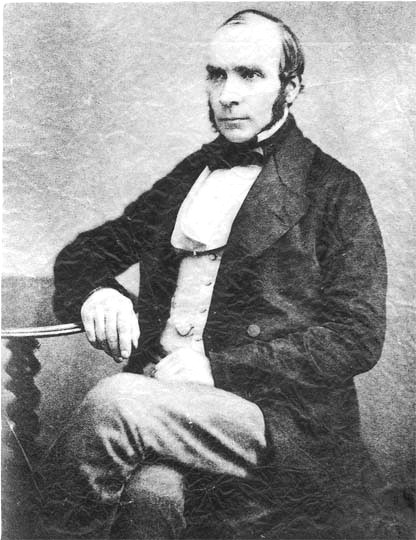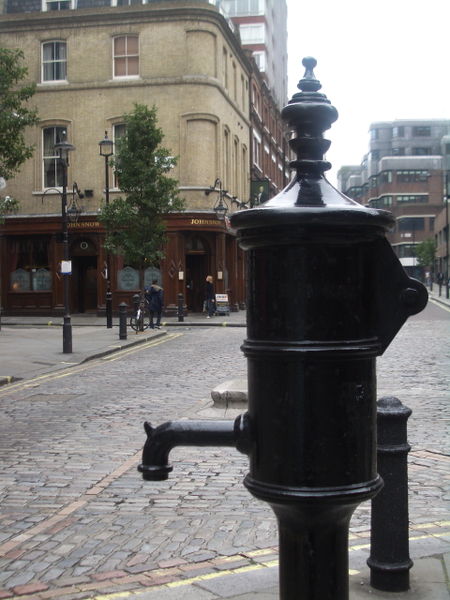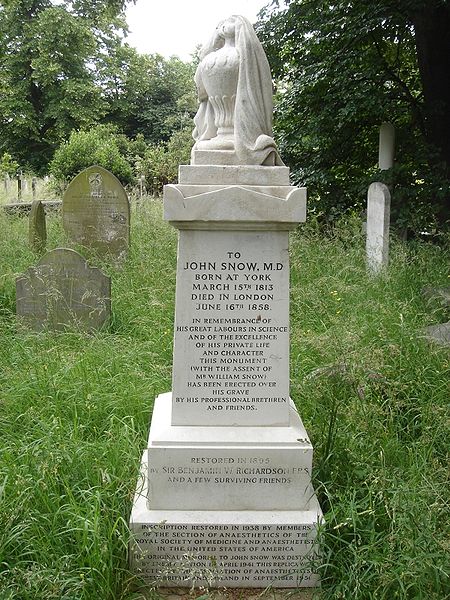<Back to Index>
- Epidemiologist John Snow, 1813
- Architect George Bähr, 1666
- 1st President of Liberia Joseph Jenkins Roberts, 1809
PAGE SPONSOR



John Snow (15 March 1813 – 16 June 1858) was a British physician and a leader in the adoption of anaesthesia and medical hygiene. He is considered to be one of the fathers of epidemiology, because of his work in tracing the source of a cholera outbreak in Soho, England, in 1854.
Snow was born 15 March 1813 in York, England. He was the first of nine children born to William and Frances Snow in their North Street home. His neighbourhood was one of the poorest in the city and was always in danger of flooding because of its proximity to the River Ouse. His father worked in the local coal yards, which were constantly replenished from the Yorkshire coalfields through the barges on the Ouse. Snow was baptised at the Anglican church of All Saints, North Street.
Snow studied in York until the age of 14, when he was apprenticed to William Hardcastle, a surgeon in Newcastle-upon-Tyne and physician to George Stephenson and family. William Hardcastle was a friend of Snow's uncle, Charles Empson, who was both a witness to Hardcastle's marriage and executor of his will. Charles Empson also went to school with Robert Stephenson and it was probably through these connections that Snow acquired his apprenticeship so far from his home town of York. Snow later worked as a colliery surgeon. Between 1833 and 1836 he was an assistant in practice, first in Burnopfield, County Durham, and then in Pateley Bridge, North Yorkshire. In October 1836 he enrolled as a student at the Hunterian school of medicine in Great Windmill Street, London. A year later, he began working at the Westminster Hospital and was admitted a member of the Royal College of Surgeons of England on 2 May 1838. He graduated from the University of London in December 1844, and was admitted to the Royal College of Physicians in 1850.
John Snow was one of the first physicians to study and calculate dosages for the use of ether and chloroform as surgical anaesthetics, allowing patients to undergo surgical and other procedures without the distress and pain they would otherwise experience. He personally administered chloroform to Queen Victoria when she gave birth to the last two of her nine children, Leopold in 1853 and Beatrice in 1857, leading to wider public acceptance of obstetric anaesthesia. Snow published an article on ether in 1847 entitled On the Inhalation of the Vapor of Ether. A longer work was published posthumously in 1858 entitled On Chloroform and Other Anaesthetics, and Their Action and Administration.
Snow was a sceptic of the then dominant miasma theory that stated that diseases such as cholera or the Black Death were caused by pollution or a noxious form of "bad air". The germ theory was not to be created until 1861, so he was unaware of the mechanism by which the disease was transmitted, but evidence led him to believe that it was not due to breathing foul air. He first publicized his theory in an essay On the Mode of Communication of Cholera in 1849. In 1855 a second edition was published, with a much more elaborate investigation of the effect of the water-supply in the Soho, London, epidemic of 1854.
By talking to local residents (with the help of Reverend Henry Whitehead), he identified the source of the outbreak as the public water pump on Broad Street (now Broadwick Street). Although Snow's chemical and microscope examination of a sample of the Broad Street pump water was not able to conclusively prove its danger, his studies of the pattern of the disease were convincing enough to persuade the local council to disable the well pump by removing its handle. Although this action has been commonly reported as ending the outbreak, the epidemic may have already been in rapid decline, as explained by Snow himself:
There is no doubt that the mortality was much diminished, as I said before, by the flight of the population, which commenced soon after the outbreak; but the attacks had so far diminished before the use of the water was stopped, that it is impossible to decide whether the well still contained the cholera poison in an active state, or whether, from some cause, the water had become free from it.
Snow later used a spot map to illustrate how cases of cholera were centred around the pump. He also made a solid use of statistics to illustrate the connection between the quality of the source of water and cholera cases. He showed that the Southwark and Vauxhall Waterworks Company was taking water from sewage-polluted sections of the Thames and delivering the water to homes with an increased incidence of cholera. Snow's study was a major event in the history of public health, and geography, and can be regarded as the founding event of the science of epidemiology. In Snow's own words:
On proceeding to the spot, I found that nearly all the deaths had taken place within a short distance of the [Broad Street] pump. There were only ten deaths in houses situated decidedly nearer to another street-pump. In five of these cases the families of the deceased persons informed me that they always sent to the pump in Broad Street, as they preferred the water to that of the pumps which were nearer. In three other cases, the deceased were children who went to school near the pump in Broad Street...With regard to the deaths occurring in the locality belonging to the pump, there were 61 instances in which I was informed that the deceased persons used to drink the pump water from Broad Street, either constantly or occasionally...
The result of the inquiry, then, is, that there has been no particular outbreak or prevalence of cholera in this part of London except among the persons who were in the habit of drinking the water of the above-mentioned pump well.
I had an interview with the Board of Guardians of St James's parish, on the evening of the 7th inst [Sept 7], and represented the above circumstances to them. In consequence of what I said, the handle of the pump was removed on the following day.
—John Snow, letter to the editor of the Medical Times and Gazette
It was discovered later that this public well had been dug only three feet from an old cesspit that
had begun to leak fecal bacteria. A baby who had contracted cholera
from another source had its nappies washed into this cesspit, the
opening of which was under a nearby house that had been rebuilt farther
away after a fire had destroyed the previous structure, and the street
was widened by the city. It was common at the time to have a cesspit
under most homes. Most families tried to have their raw sewage
collected and dumped in the Thames to prevent their cesspit from
filling faster than the sewage could decompose into the soil. After
the cholera epidemic had subsided, government officials replaced the
Broad Street Pump Handle. They had responded only to the urgent threat
posed to the population, and afterward they rejected Snow's theory. To
accept his proposal would be indirectly accepting the oral-fecal method
transmission of disease, which was too unpleasant for most of the
public. Public
health officials today recognize the political struggles in which
reformers often become entangled. During the Annual Pumphandle Lecture
in England, members of the John Snow Society remove and then replace a
pump handle to symbolize the continuing challenges that face public
health advancements. Snow was a vegetarian and an ardent teetotaler and believed in drinking pure water (via boiling) throughout his adult life. He never married. At the age of 45, Snow suffered a stroke while working in his London office on 10 June 1858. He never recovered, dying on 16 June 1858 and is buried in Brompton Cemetery. There
is a plaque commemorating Snow and his 1854 study in the place of the
water pump on Broad Street (now Broadwick Street) with a water pump
with its handle removed, near what is now "The John Snow" public house, which is rather ironic, given that Snow was a teetotaler for the majority of his life. The spot where the pump stood is covered with red granite. In York, there is a blue plaque to
Snow on the west end of the Park Inn, a hotel in North Street. John
Snow was voted in a poll of British doctors in 2003 as the greatest
physician of all time. Snow gives his name to John Snow College, founded in 2001 on the University of Durham's Queen's Campus in Stockton-on-Tees. Snow is one of the heraldic supporters of the Royal College of Anaesthetists. The public health consulting firm John Snow, Inc is named after him.